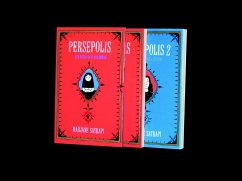Persepolis: The Story of a Childhood Wise, funny, and heartbreaking, Persepolis is Marjane Satrapi's memoir of growing up in Iran during the Islamic Revolution. In powerful black-and-white comic strip images, Satrapi tells the story of her life in Tehran from ages six to fourteen, years that saw the overthrow of the Shah's regime, the triumph of the Islamic Revolution, and the devastating effects of war with Iraq. The intelligent and outspoken only child of committed Marxists and the great-granddaughter of one of Iran's last emperors, Marjane bears witness to a childhood uniquely entwined with the history of her country. Persepolis paints an unforgettable portrait of daily life in Iran and of the bewildering contradictions between home life and public life. Marjane's child's-eye view of dethroned emperors, state-sanctioned whippings, and heroes of the revolution allows us to learn as she does the history of this fascinating country and of her own extraordinary family. Intensely personal, profoundly political, and wholly original, Persepolis is at once a story of growing up and a reminder of the human cost of war and political repression. It shows how we carry on, with laughter and tears, in the face of absurdity. And, finally, it introduces us to an irresistible little girl with whom we cannot help but fall in love. Persepolis 2: The Story of a Return Here is the continuation of Marjane Satrapi's fascinating story. In 1984, Marjane flees fundamentalism and the war with Iraq to begin a new life in Vienna. Once there, she faces the trials of adolescence far from her friends and family, and while she soon carves out a place for herself among a group of fellow outsiders, she continues to struggle for a sense of belonging. Finding that she misses her home more than she can stand, Marjane returns to Iran after graduation. Her difficult homecoming forces her to confront the changes both she and her country have undergone in her absence and her shame at what she perceives as her failure in Austria. Marjane allows her past to weigh heavily on her until she finds some like-minded friends, falls in love, and begins studying art at a university. However, the repression and state-sanctioned chauvinism eventually lead her to question whether she can have a future in Iran. As funny and poignant as its predecessor, Persepolis 2 is another clear-eyed and searing condemnation of the human cost of fundamentalism. In its depiction of the struggles of growing up—here compounded by Marjane's status as an outsider both abroad and at home—it is raw, honest, and incredibly illuminating.

Graphic Novels Band 2
Unkeusche
Bewegungen
„Persepolis“ von
Marjane Satrapi
Da hasten Verfolger mit Käppi und Schlagstock die Treppe hinauf. Einem Mann hinterher, der über die Dächer flieht, von Haus zu Haus springt, bis er fällt, fast meint man, ihn nach dem Mond greifen zu sehen, bevor er stürzt. Dieser Albtraum – ein Freund wird von Polizisten zu Tode gehetzt, weil er verbotenerweise zusammen mit Frauen auf einer Party war – wird von Marjane Satrapi als Abfolge von Scherenschnitten gezeichnet. Das rennende, ins Leere springende Männchen ist winzig und ohne Individualität, wie bei einem Piktogramm. Auf dem letzten Bild ist nur der Mond über dem Schacht zwischen zwei Häusern zu sehen. Und in diesem leeren, fast schon abstrakten Bild können sich Entsetzen und Sprachlosigkeit ausbreiten. Die Annäherung an etwas so Ungeheuerliches funktioniert nur aus der Distanz.
Art Spiegelman hatte es vorgemacht in seinem Holocaust-Comic „Maus“, wie man vom Unbeschreiblichen erzählen kann mit den Mitteln des Comics. Marjane Satrapi hat in „Persepolis“ ihre eigene Kindheit und Jugend im postrevolutionären Iran nach-erfunden, so grimmig komisch, herzergreifend und vor allem für Leser aus dem Westen erhellend, dass ihr 2000 bis 2003 erschienenes Buch ein internationaler Bestseller wurde und die immer noch anhaltende Erfolgsgeschichte der Graphic Novels begründete.
Schlicht, ja beinahe naiv wirken die Schwarz-Weiß-Zeichnungen der 1969 geborenen Exiliranerin, die mittlerweile in Paris lebt. Sie bilden einen reizvollen Kontrast zu den historischen Großereignissen, von denen Satrapi erzählt, Islamische Revolution und Iran-Irak-Krieg, vor allem aber geben sie das Befremden der jungen Marjane wieder, angesichts der Geschehnisse in ihrem Land. Je bizarrer oder grauenvoller es wurde, desto holzschnittartiger hat sie gezeichnet. Und das Ganze mit einem Witz versehen, der befreiend sein kann, aber auch unerbittlich. Dabei trägt der Tugendterror der Revolutionswächter die Satire schon in sich, wenn etwa Kunststudentinnen in der Anatomie-Klasse eine vollverschleierte Frau zeichnen sollen oder der (mittlerweile erwachsenen) Marjane das Rennen auf der Straße von Sittenwächtern verboten wird: „Wenn Sie rennen, macht Ihr Hinterteil Bewegungen . . . nun . . . unkeusche Bewegungen!“ Was Marjane zu dem Ausruf treibt: „Dann glotzt mir doch nicht auf den Arsch!“
Indem Schleierzwang und Märtyrerverehrung in eine Coming-of-age-Geschichte eingebettet werden, macht „Persepolis“ ein Land erlebbar, das als Schurkenstaat galt (und manchen immer noch gilt), dessen Alltag im Westen aber nahezu unbekannt ist. Und Marjane ist eine Heldin nach unserem Geschmack: eigensinnig und rebellisch, auch im europäischen Exil, in das sie 14-jährig geht, weil ihre Eltern um die Sicherheit des aufmüpfigen Mädchens fürchten. In Wien aber hält Marjanes entsetztes Staunen an, und Satrapis Schwarzweißmalerei wird zum Ausdruck einer unauflösbaren Fremdheit, zur Zeichensprache des Exils.
MARTINA KNOBEN
Marjane Satrapi Foto: dpa
SZdigital: Alle Rechte vorbehalten - Süddeutsche Zeitung GmbH, München
Jegliche Veröffentlichung und nicht-private Nutzung exklusiv über www.sz-content.de








